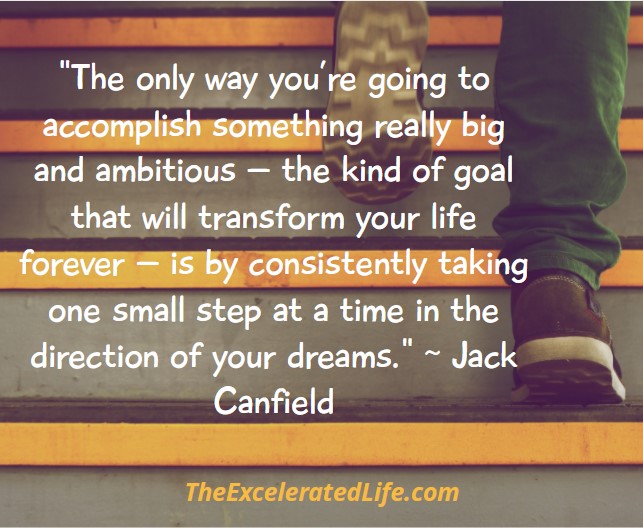A BIG goal is necessary for growth and self-development, but a BIG goal alone is not enough. To sneak past the amygdala, to avoid the motivation trap, and to sustain the effort needed until you reach your goal, you must break it down into tiny steps you can take every day. Tiny steps lead to big changes.
TheExceleratedLife.com
Title Photo by Ben Mack from Pexels
A Great Start
It was December 31. New Year’s Day was on the way and Rusty decided it was time to make some BIG changes. He had been steadily gaining weight over the last few years and now was the time to drop those extra pounds – 50 to be exact. He was thousands of dollars in debt but he was determined to start the new year on a different tack.
Rusty decided he’d cut his expenditures to the basics, pay off his debt, and save at least $1000. He also had a dream that he’d been thinking about for years. Rusty wanted to write a book, a novel for a storyline he’d carried around in his head all that time. And this was the year to finally get it down on paper! As he celebrated the coming of the new year with his family, Rusty was excited to get started on his new life!
So the next morning, Rusty sat down to a breakfast of a green smoothie and a hard-boiled egg. He had a salad for lunch and salmon and steamed vegetables for dinner. During the day, he set up a budget that drastically cut his expenses. And that evening, he sat at his desk and began outlining his novel. He figured he could easily write 5000 words a day and have it completed in a few months. Rusty was off to a great start!
After a week of smoothies, salads, and salmon, Rusty was starving for a juicy cheeseburger. He sneaked out at lunch one day and scarfed down a giant burger with fries and a soft drink. He felt so guilty afterward that he drowned his feelings in a 6-pack of beer. The new diet wasn’t working and Rusty decided he’d never be able to stick with it, so he may as well eat what he wanted and get used to being fat.
At about the same time, Rusty’s car broke down. Another emergency. He had to have it repaired but had to put the expense on his credit card. It was no use to try to save money, he decided. He might as well enjoy living while he could. He could make the minimum payments on his credit cards and still have money to spend.
The first few days of book-writing were amazing. Words seem to flow from Rusty’s fingers to the page. But after the first couple of chapters, he hit a snag. He struggled to get 5000 words written that day. The next day, he only wrote a couple of thousand. The next day, he decided he needed a day off, a break from writing. The next day, he forgot. Two weeks later, his manuscript sat in a folder on his PC, unopened and forgotten.
Rusty had re-lived what he’d lived so many new years before, and he experienced the same things most of us have lived out in the past. We have grand plans and schemes to overhaul our lives, to take giant steps to reach massive goals. But soon, motivation wanes, and it’s well-nigh impossible to sustain the effort required to make these grand changes. Eventually, we drift back into old, comfortable habits of behavior. We don’t understand or we forget that tiny steps lead to big changes.

How tiny Steps Lead To BIG Changes
As our friend Rusty discovered, having a BIG goal by itself is not enough. It may get you started, but the efforts required to make big changes are mostly impossible to sustain. You are much more likely to reach your goal, even your BIG goal if you take consistent tiny steps.
Consider Shawn Achor’s “20-second rule”. As Shawn recounts in The Happiness Advantage, he wanted to create a habit of practicing the guitar to improve his playing. He taped a spreadsheet with 21 columns to his wall, determined to play every day for 21 days, based on the old idea that it takes that many days to create a habit. But at the end of those 21 days, he “pulled the grid down in disgust. Staring up at four checkmarks followed by a whole lot of empty boxes, was more discouragement and embarrassment” than he wanted. As it turns out, Shawn kept his guitar in a case in the closet and it took about 20 seconds to get it out. That proved too much of an effort and scuttled his guitar practice.
Then Shawn had another idea. If a 20-second time period proved too great an obstacle to doing something he wanted to do, could it also keep him from doing things he didn’t want to do? Things like watching too much TV. He removed the batteries from his TV remote control and placed them in a drawer that was about 20 seconds away from the sofa where he watched TV. Then, he placed his guitar on a stand next to the sofa.
For several days, when he got home, he plopped down on the sofa and reached for the remote, forgetting that he’d removed the batteries. He was frustrated when the remote control didn’t work, but instead of getting up and walking the 20 seconds to where the batteries were stored, he picked up the guitar because that was easier. [Achor] By making the desired behavior easier to do than the undesired behavior, he was able to exchange an unhelpful habit for a positive one.
Want another example of how tiny steps can lead to BIG changes? If you spent 10 minutes every day doing something, that is 1 hour and 10 minutes a week you’d do that activity. That comes out to a little over 60 hours in a year’s time. That’s one and a half 40 hour work weeks you’d spend on your goal. Even if you took Sundays off, you’d still have put in 52 hours. How much further could you be if you invested 52 hours into your goal? [Thurnell-Read]
Why Is This Important?
One major reason to break your BIG goal into tiny steps is to sneak past the amygdala, the part of the brain that controls our response to fear. Simply thinking about making a major change, even if it’s a change for the better, can set off a reaction in the amygdala. It can stop you in your tracks before you ever get started. But by stating your intentions in small, incremental steps, you can progress without setting off warning signals and sending your brain and your body into fight or flight mode. [Maurer]
Another important aspect of taking small steps is that they are sustainable. You are better able to do them even on the days you “don’t feel like it” or “don’t have the time” or “have too many interruptions” or “(insert your favorite excuse here)”. Consistency is the key to making progress over time. And you can only be consistent when you can take your goal step even on the days you are sick, tired, overwhelmed, distracted, bored, etc., etc. You can always take more than one step, if they are small enough, on the days you are on point. But you should always be able to take at least one step on any day, no matter what else is going on.
A third factor to consider is motivation; or rather, the lack thereof. “Motivation is unreliable,” says behavior expert BJ Fogg. [Fogg] Motivation fluctuates, depending on many factors, some of which you may not even be aware of. Sometimes, we have conflicting motivations. When your motivation is high, you can do difficult things, take giant steps toward your goal. But when motivation is low, your ability to take those big steps wanes. But if you make the steps easy enough, tiny enough, you’ll take them no matter your level of motivation.

If You’re Not Moving Forward . . .
I’m not sure where I first heard this, but I know it’s true: If you’re not moving forward, you’re moving backward. There is no standing still.
I frequently remind myself of Jim Rohn’s “two easies”: easy TO do and easy NOT to do. Small steps leading to your goal are easy to do. They’re also easy not to do. And it won’t make much difference if you do them or not . . . at first.
But keep in mind Jeff Olson’s definition of “success”: a few small, simple, easy actions repeated every day. And failure? A few simple errors in judgment repeated every day. [Olson] You’re either heading upward on Life’s path or you are headed on a downward slope. Trouble is, you don’t see it in your everyday results for a long time; weeks, months, even years.
Are you moving forward? You may not even know by looking at your surroundings. But if you are not taking that small step toward the life you want – and doing it most days – chances are good that you are on the downward slope. And you might not recognize it till it’s too late.
So what can you do?
Break BIG Goals Into tiny Steps
A good workable way to break your goals into steps is to use Sean Young’s stepladders model.
In this model, you start with a dream, something you’ve never done before. (If you have done it before it is a goal.) Divide your dream into goals. Goals represent the targets you’ll hit on your way to realizing your dream.
Goals are either long-term (six months to a year) or short-term (one to three months). Break your long-term goals into smaller short-term goals. Finally, break your short-term goals into the small steps you will take each day. Ideally, these steps are actions you can do in 10 minutes to a half-hour. Remember, you can always do more on the good days, but you want your steps small enough so you can take a least one per day, regardless of anything else that happens.
Another thing to keep in mind as you think about your steps is priority. It isn’t all that helpful to get things done if you aren’t doing the right things. All the productivity tools in the world won’t help you much if you aren’t doing the things that move you toward your goals. It is essential that you know the steps you must take AND know which one comes first, which one comes second, etc. Successfully completing tasks that lead you nowhere is counter-productive. In order to work on your most important task, you must know what it is. And you know that by prioritizing.
Won’t I Get There Faster If I Take Giant Steps?
The fact is that, sure, taking giant steps gets you farther than tiny steps, if taken over the same time period. But the bigger fact is that few of us can sustain those steps. We might start out with a massive effort, but sooner or later, and usually sooner, we oversleep, or the kids get sick, or the car breaks down, or the bus runs late, or it’s raining, or it’s snowing, or the sun’s too hot, or the boss is having a bad day. We call this life and it gets in the way of the best of intentions.
We’ve already seen that big steps can spook the amygdala and let fear take over. We’ve seen that motivation is a fickle dance partner and cannot be counted on. And common sense tells us no BIG goal is going to be achieved in a week or even two. Big goals DO require massive action, but massive action that is accumulated as small steps consistently over an extended period.
Jack Canfield writes in the blog post “How Small Steps Make Big Changes”: “The only way you’re going to accomplish something really big and ambitious – the kind of goal that will transform your life forever – is by consistently taking one small step at a time in the direction of your dreams.” [Canfield]
So, sure, you could reach your goal faster IF you could consistently take the giant steps. But the likelihood of that happening is slim to none. You’re much more likely to make it by taking small consistent actions day after day after day.
How Do I Start?
You start, of course, with a BIG goal. If you don’t have a BIG goal, do this first. The Goal Achievement Excelerator leads you through the steps of defining your goal, selecting strategies to reach your objective, and designing actions for each strategic step. As you design your actions, keep these points in mind.
The key to getting started is to make the first step toward your goal so easy, that it is almost easier to do it than not to do it. Or as I frequently tell clients, so easy that you’ll be embarrassed if you don’t do it.
Replace vague ambitions with specific, manageable actions you’re confident you can reach. [Booth] We sometimes speak of process goals vs. outcome goals. Your outcome goal is that final BIG goal that you’ll reach sometime in the future. Focus on your process goals – the tiny steps you’ll take every day to reach the final destination. This allows you to be and to feel successful every day that you take the step.
Link new behaviors to existing actions. Also known as habit stacking, this is a helpful way to remember to take your goal steps until they become a habit. Let a behavior you do consistently now prompt you to take your new action.
Be consistent. It’s key.
Track your progress. Because you’ll be taking tiny actions, you won’t see much visible progress, often for a long time. To keep you on track, use a chart or a calendar to mark every day you complete your goal step. Seeing those checkmarks, or gold stars, (or however you choose to track), mount up is motivation to keep the streak going. The more you get, the more you’ll want to do the step today. And one day, in the not-so-distant future, you’ll realize how far you’ve progressed.
tiny Steps Lead To BIG Changes
So, as we’ve seen, a BIG goal is necessary for growth and self-development, but a BIG goal alone is not enough. To sneak past the amygdala, to avoid the motivation trap, and to sustain the effort needed until you reach your goal, you must break it down into the tiny steps you can take every day.
Tiny steps lead to big changes. It’s impossible to lose 50 pounds overnight. It is eminently possible to replace a doughnut with a healthier breakfast choice. It’s impossible to increase your savings by $1000 over a weekend. It’s easy to skip the latte on your way to work each day and save that money. It is impossible to complete a book in a day. It is highly possible to write 50 words. So replace the doughnut. Skip the latte. Write 50 words. Then do it again tomorrow. And the next day. And the next. Now you’re embracing your Excelerated Life™!
Excelerated Goal Setting™ — planning and achieving BIG (Bold, Important, Gratifying) goals — is one step in creating your Excelerated Life™, a life of flourishing and well-being, and a life of meaning, purpose, and service.
Read more about the Excelerated Life™.
Resources:
Achor, Shawn. The Happiness Advantage. New York: Crown Publishing Group, 2010.
Booth, Stephanie. “Make Big Changes With Small Steps.” WebMD. WebMD LLC, November 19, 2020. Web. January 15, 2022.
https://www.webmd.com/balance/big-changes-small-steps
Canfield, Jack. “How Small Steps Make Big Changes.” Linked In. LinkedIn Corporation, February 14, 2019. Web. January 15, 2022.
https://www.linkedin.com/pulse/how-small-steps-make-big-changes-jack-canfield/
Fogg, Ph.D., BJ. Tiny Habits: The Small Changes That Change Everything. New York: Houghton Mifflin Harcourt Publishing Company, 2020.
Maurer, Ph.D., Robert. One Small Step Can Change Your Life. New York: Workman Publishing, 2004.
Olson, Jeff. The Slight Edge. Austin, TX: Greenleaf Book Group Press, 2005-2013.
Thurnell-Read, Jane. “How do small steps make big changes?” Health, Happiness, and Well-being. Jane Thurnell-Read,. Web. January 15, 2022.
https://www.janethurnellread.com/how-do-small-steps-make-big-changes/


